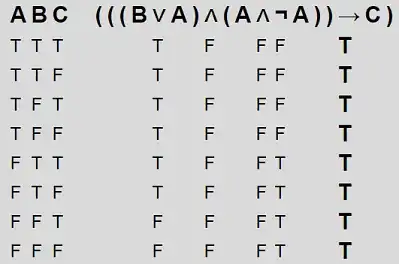I have this truth table:

And I'm trying to determine the validity of the argument, which is:
(B v A), (A ^ ¬A) therefore C
I've got one row at the bottom, where (B v A) and (A ^ ¬A) are both false, but C is true. And the one below that has all false premises and a false conclusion.
Maybe this is a dumb question, but can an argument still be valid even if either (1) all the premises are false but still has a true conclusion or (2) all premises and conclusion are false?
Furthermore, does an argument lacking any row in which all premises are true + conclusion is true automatically mean that the argument is invalid?
I would like to make it clear that I do understand that if a truth table contains a row in which all premises are true but the conclusion is false the argument is invalid.
Thanks.
(Note: the table has (A v ¬A), but it is meant to read as (A ^ ¬A). My bad!
